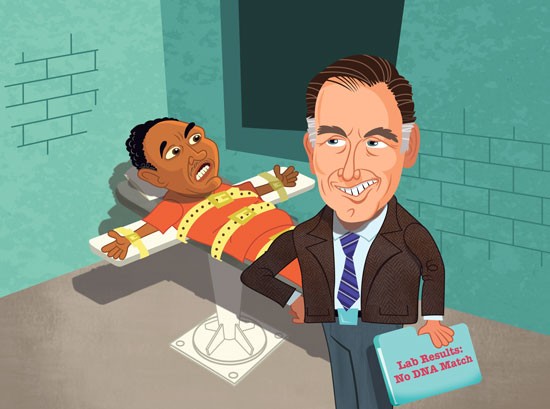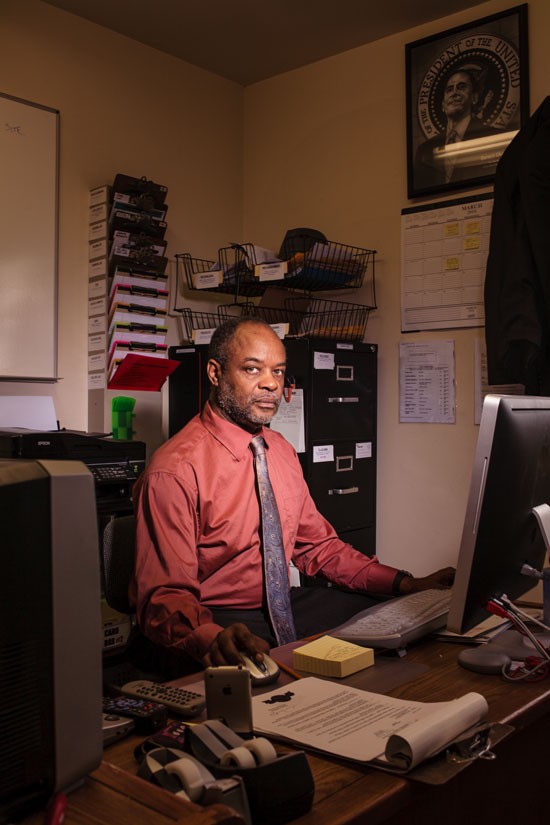
At the age of 5 on Nov. 15, 1984, Jerrod Hessling witnessed the murder of his family’s live-in babysitter, Linda Faye Rodgers. Jerrod watched the killer strike Rodgers with a metal chain, drag her to the master bedroom inside his ranch-style residence on the 1700 block of West Wilshire Avenue in Santa Ana, and then retrieve a knife from the kitchen and a hammer from another room before demanding the location of drugs and cash. In the aftermath, the bound, semi-stripped, 25-year-old woman, who had been beaten, raped and repeatedly stabbed, lay dead on the bed. Blood spatter on the ceiling and walls signaled the attack’s ferociousness. A used white vibrator found near her thighs added to the grisly display.
When police arrived at the crime scene, Jerrod described the killer as a “white man” wearing “a white shirt, black belt and white pants.” As a cop later testified, officers transported the boy to the police station to “see if he could differentiate races.” They displayed photographs of two Asian males, two Caucasian males, a Latino and two African-Americans and asked him to identify the men by race. He easily performed the task. After they repeatedly tested the boy’s memory of the murder, the detectives noted that his description of the killer didn’t change.
However, according to court records, at least three adults in the boy’s life wanted him to label the killer a black man: his mother, Margaret Henriksen, a welfare scammer; his stepfather Kai Henriksen, a convicted killer and member of a whites-only, Southern California biker club called the Nuggets; and Michael A. Jacobs, a prosecutor in the Orange County district attorney’s office (OCDA).
From the outset of the investigation, Jacobs pursued a lone suspect: Kenneth Clair. The 25-year-old, ninth-grade high-school dropout with a robbery conviction from New Orleans had moved to California a year earlier, but because of family neglect and his own substance-abuse issues, he wound up homeless in Orange County. In the months before Rodgers’ murder, he’d squatted on and off in a vacant residence next door. Authorities even believe he’d burglarized the Henriksen home a week before the death. But Jacobs had a huge problem: The main witness said the killer was white, and Clair is unmistakably a dark-skinned African-American.
Putting Jerrod on the witness stand at a preliminary hearing, the prosecutor asked if he’d know the killer if he saw him again. The boy answered affirmatively. Jacobs pointed at Clair, who was seated at the defense table in the courtroom and asked, “Do you recognize that man or not?”
According to the official transcript, Jerrod shook his head negatively before saying, “No.”
Jacobs shot back, “You don’t?”
“No.”
“What?”
“No.”
“You don’t think that’s him?”
“No.”
Jacobs tried to break the kid’s resolve that day, but the effort failed as the witness uttered “no” a fifth time.
At a later deposition, the prosecutor explained away Jerrod’s observations. “My experience tells me that children, particularly in traumatic situations, aren’t good at recounting what happens,” Jacobs said. “And they are particularly less observant about color than adults.” Pressed for backup, he admitted he really hadn’t had meaningful experiences with child witnesses.
Nonetheless, Jacobs, who mimicked the defendant’s colloquial black English at trial, still won a conviction. Clair is now a resident of San Quentin State Prison’s notorious death row. California officials want to execute him, but a date has yet to be selected.
How Clair landed in this predicament is a story of sloppy police work, unsavory government witnesses, incompetent defense lawyering and a sneaky prosecutor who helped to keep more than a dozen crucial, pro-defense facts from an overwhelmingly Caucasian jury. Yet this story is more than an alarming history lesson. Evidence shows that the same unethical, win-at-all-costs prosecution mindset employed against Clair 28 years ago continues to taint present-day cases in Orange County.

Most citizens probably assume our criminal-justice system is loaded with fail-safe checks and balances that guarantee the innocent are never convicted, especially in death-penalty cases. That notion is too often a fantasy in Orange County. Twenty-three months into what has become known nationally as the OC snitch scandal, three overarching conclusions have crystalized for anyone still in the dark.
The integrity of our system relies on the integrity of prosecutors who alert defense lawyers to the existence of government-possessed exculpatory evidence and turn the records over in a timely fashion. There are plenty of games dishonest deputy DAs can play to sandbag unwitting defendants, win questionable if not downright erroneous convictions, and then callously celebrate another victory that can be added to their résumés. And while certain OCDA prosecutors and investigators earned praise during the past decade for solving complex cold-case murders, some of their colleagues, who may look the part of Bible-study teachers, are, in reality, relentless cheaters.
Weekly readers are already familiar with Jacobs. He’s the prosecutor who viewed himself as the courthouse Terminator, bragging about his knack for handing defendants the death penalty and mocking those in law enforcement whom he didn’t believe shared his enthusiasm. How shameless was this prosecutor? Jacobs wrote himself into a disconcerting footnote in the annals of our nation’s legal system by convicting two men, eventually state-executed Thomas Thompson and still-imprisoned David Leitch, for the same Laguna Beach murder by hiding records and arguing contradictory facts to two separate juries. (See “Recent Proof of Prosecutorial Misconduct Mirrors OCDA’s Bad Old Days,” May 6.)
The Thompson/Leitch scam pleased Tony Rackauckas, his old colleague who named Jacobs the head of the OCDA homicide unit when he became DA in 1999. Rackauckas fired him two years later for insubordination and dishonesty. Since then, revelation after revelation in multiple cases has enhanced Jacobs’ reputation as a prosecutor who’d been on the prowl to tilt the scales of justice against his targets, including Thompson, Leitch, Clair and William Charles Payton.
In Payton’s death-penalty case, Jacobs and sheriff’s deputies employed jailhouse informants Alejandro Garcia and Daniel Escalara to secure self-incriminating statements by the defendant in violation of a ruling called Massiah, which bans the government from surreptitiously coaxing self-incriminating utterances from suspects who have already been charged and have legal representation. Law enforcement claimed Escalara, a Mexican Mafia associate, hadn’t been a secret agent and had accidentally overheard Payton talk, a scenario that—if true—meant rightful inclusion in a trial. But officials had concocted a ruse.
OCDA deceptions didn’t end there. The prosecutor kept the defense from learning additional information that would have eviscerated Escalara’s credibility with the jury. While working as a snitch, the convicted armed robber committed a second violent robbery with a knife. Neither Payton’s jurors nor lawyers knew Jacobs would reward the thug for his assistance with probation instead of prison or that, once free, the government tool would use a gun to kill an innocent victim during a third robbery. Nor did anyone outside the government know Escalara ordered a murder of another hoodlum working as a law-enforcement snitch, according to court records.
Jacobs made sure he’d clandestinely smothered any chance Payton’s lawyers could impeach his star witness because he hid damning information contained in the Orange County Informant Index (OCII). When the California Attorney General’s office took over defense of the death-penalty conviction in 1999, they learned of the prosecutor’s fraud with the OCII and that he’d misrepresented his role in the sweetheart Escalara deal.
Chief Assistant AG David Druliner told Rackauckas and Jacobs he would report the transgressions if they didn’t surrender the OCII to Payton’s appellate lawyers. The prosecutor balked, writing in a terse letter that OCDA considered the index beyond the reach of a judge. Late last year, the public learned that Sheriff Sandra Hutchens’ deputies inside the Orange County Sheriff’s Department (OCSD) used the same excuse to conceal 25 years’ worth of records in a computer system called TRED that contains exculpatory information on untold numbers of defendants.
Credit for uncovering the OCII and TRED schemes goes to Scott Sanders, an assistant public defender. His investigations since 2013 have become a nightmare for OCDA and OCSD; entrenched cops, including Hutchens, insist inadvertent errors have been artificially twisted into acts of dishonesty, a stance Sanders finds laughable. “There are hundreds, if not thousands, of cases in which similar, if not worse, misconduct has simply remained entirely hidden from view,” he declared in August.

In the days before her murder, Rodgers called her mother in Florida, told her she wanted to move out of the Henriksens’ residence, voiced fears for her safety and predicted she would not live to see her 26th birthday. At the time, she didn’t know Clair.
But she’d had disputes with Kai Henriksen, who had a rap sheet for committing voluntary manslaughter in 1965 and thought she owed him $300, according to court records. Neighbors reported screaming and death threats coming from inside the house before the murder. They also saw a daily traffic of individuals dropping by the residence for brief periods, a pattern that seemed to indicate drugs were being sold there. Indeed, police collected witness statements that stated the Henriksens were “heavy meth users” who’d “frequently” thrown biker parties. Furthermore, witnesses claimed, Rodgers had been a “house mouse,” serving as a combination babysitter/sex slave for the couple.
Those circumstances coupled with the location of the residence on the cusp of a region claimed by the F Troop criminal street gang should have caused Jacobs and police to cast a wide suspect net. But Jacobs’ laser-like focus on Clair didn’t account for inconvenient facts. Instead, he compiled the best case he could against Clair. As in his other cases, those tactics included unethical moves. For example, OCDA arrested Margaret Henriksen for welfare fraud after the murder; waited for her to testify against the defendant, with charges looming; then, days after the end of Clair’s case, gave her a sweetheart deal. Jurors remained unaware of the maneuvering.
The defense didn’t match the prosecutor’s aggressiveness. Julian Bailey, Clair’s lawyer, a former prosecutor working his first death-penalty case, made stunningly questionable trial decisions. Bailey didn’t call Jerrod to the stand to tell jurors about his original statement concerning the killer’s race, failed to alert them to the contents of the victim’s call to her mother, botched objecting properly to Jacobs’ suspicious peremptory strikes that booted three of four African-Americans from the juror panel, and allowed them to render a verdict without being apprised of the drug allegations. In a 2008 media interview, Bailey, who is now a judge, deflected any notion of his own incompetence and sold out his client, telling reporters the evidence against Clair had been “pretty overwhelming.”
Four years earlier, Bailey hadn’t been so smug. “I never interviewed Jerrod or any of the other children or adults who lived in the house,” he acknowledged in an August 2004 affidavit obtained by the Weekly. “My failure to do so may have been deficient lawyering on my part.”
Appellate lawyers for Clair were aghast. They observed, “Had the jury known that the house was a drug house, the jury would have understood that the murderer may have been one of the many perpetrators of violence in the drug trade—a desperate user, a dissatisfied customer, a stiffed supplier or a rival dealer—rather than a transient stranger, who happened to be living next door.”
They had a point. There is no fingerprint, hair or DNA evidence putting Clair within the crime scene. Detectives could not find any eyewitnesses to counter Jerrod’s description of the killer or that of another child who witnessed the killing and saw a white man’s tattooed arm reach inside the residence to open a sliding glass door. Upon learning in 1999 how many facts hadn’t been introduced at trial, juror Beverly Bragassa said she felt hoodwinked. “I cannot understand why the jury was not told this information, and it makes me mad at the judicial system,” she declared.

Jurors also did not know of the prosecution team’s sly management of another witness. According to court records, Pauline Flores, Clair’s girlfriend, wanted “payback” because she thought he’d cheated on her. Flores claimed she had been his companion immediately before and just after the murder, and when she asked him that night what he’d been doing during an hour intermittence, the defendant supposedly said he’d been “beating up a woman.”
Her account had problems for the cops, however. Santa Ana police detectives believed the killer would have been soiled with blood spatter, but Flores saw nothing unusual about his clothing. She did report seeing him with several items—stereo speakers, a blanket, a six-pack of Budweiser and jewelry—that the Henriksens later said were stolen from their house during the time of the killing.
Jacobs believed he possessed the most important piece of evidence proving his case: a surreptitious police recording Flores made of Clair about four months after the murder. He summarized the tape’s contents for jurors, claiming the defendant had essentially said, “No big deal. . . . All I did was kill somebody.” His version fudged the truth.
On the recording, Clair denied being the killer, but in response to her repeated demands to admit his guilt, he also made potentially incriminating statements, including “They can’t prove a motherfucking thing, not unless you open your fucking mouth,” “Nobody seen nothing” and “Baby, what you fail to realize [is] how the motherfuckers gonna prove I was there?”
Had he confessed or simply stated a fact that he hadn’t been at the house and therefore nobody saw him there? Jacobs thought the sentences unquestionably proved guilt beyond a reasonable doubt. Years later, in May 1992, the California Supreme Court agreed, opining Clair’s words were “sufficiently substantial to support a conclusion that the defendant was indeed the perpetrator”—enough to execute him.
But doubts continued to emerge. In 2001 and 2005, Flores admitted she’d testified wrongly about placing Clair near the house on the night of the murder. She had been bedridden, heavily medicated and mentally foggy at the time from a bike accident that had resulted in severe head trauma. “I could not have gone out of the house [that week],” she recalled under oath in a statement.
What caused her contradictory testimony? “The police detective took advantage of my mental state at the time,” she claimed, “which was a combination of the injuries that I sustained in the accident and my immediate anger and hatred of Kenneth Clair, to manipulate me into assisting them in placing [him] at the crime scene and murder of Linda Rodgers.”
Jerrod’s racial identification of the killer flip-flopped between the preliminary hearing and what he stated under oath during the trial. In 2004, he explained that his stepfather “hated black people” and had lobbied him to change his stance. “I remember him saying to me, ‘Are you sure it’s not that nigger? I think it was him.'”
The resulting flip-flop helped to ruin Clair’s defense. “After Kai said these things to me, I changed my description of the assailant to being a black man,” Jerrod recalls. According to court records, Jerrod now believes a biker killed Rodgers after she threatened to report his stepdad to the authorities “because of all the drug dealing going [on] in our house.”
Despite the recanting of both key witnesses, OCDA officials continued to defend Clair’s conviction. But they had another huge bombshell coming—one that would rock the government’s theory of the killing.
The relationship between Rackauckas and Jacobs ended with the prosecutor’s firing in 2001. The DA considered Jacobs dishonest, and the prosecutor fancied his boss corrupt. That’s the gist of what the public discovered about the rift. We didn’t know at the time that the AG’s office had formally but privately blasted OCDA for hiding the OCII from defense lawyers. In other words, the DA’s office could never afterward legitimately claim ignorance about the mandate for sharing the index when appropriate.
Reforms were not enacted, however. With Rackauckas in control for the next decade and a half, the office continued to bury OCII records, especially when the information undermined their cases. Sanders made that discovery while representing two pending death-penalty cases: People v. Scott Dekraai and People v. Daniel Wozniak. By 2014, Jacobs—who recently told the Weekly he committed no wrongdoing in any of his cases—was long gone, but his sneaky moves were still being copied.
Dan Wagner, Jacobs’ latest successor as chief of the OCDA’s homicide unit, refused for two years to turn over to Sanders records of prolific government snitch Fernando Perez, a Mexican Mafia killer. Superior Court Judge Thomas M. Goethals forced compliance with discovery rules. Erik S. Petersen, Wagner’s colleague who recently resigned, also made misleading representations about the OCII in separate cases. (See “Police Doctored Report, Prosecutor Lied In Wild Attempted Murder Case Near Disneyland,” Nov. 4.)
To summarize: Wagner, Petersen and others in OCDA allege their secrecy is a noble effort to shield their rats from retaliation and that that concept can outrank a defendant’s right to a fair trial. If surrendered, Perez’s record would have shown Sanders that honest cops had already labeled the snitch an untrustworthy liar before he began working with OCDA to give Dekraai the death penalty.
During the trial against Clair, Jacobs told jurors they could feel good knowing the evidence demanded a conviction, that it proved the defendant had beaten, raped and murdered Rodgers. But in 2008, nearly 21 years after the defendant landed on death row, forensic testing unavailable at the time of the trial came back with a startling conclusion: The DNA recovered in Rodgers’ vagina did not belong to Clair.
It matches another individual.
The stunning result didn’t shake Jacobs’ conviction. To him, nothing mattered but Clair’s alleged confession to Flores. He’d told the Orange County Register he didn’t care if people complained otherwise “until the cows come home.”

Having found Clair guilty of a special-circumstances murder, the prosecution and the defense turned their attention to taking opposing positions about whether he should get life in prison without the possibility of parole or death. Jacobs, of course, wanted the ultimate punishment. Bailey, the defense lawyer angling for the lesser punishment, took the same lackluster approach he’d used in the unsuccessful trial stage.
According to court records, Bailey didn’t prepare key witnesses or thoroughly interview people knowledgeable about his client’s life story. He did describe Clair as enduring a “poor” background. But that weak description robbed jurors of a fair counterposition to Jacobs’ insistence he was a monster.
Here’s the true story Bailey could have told the jury, but didn’t: Clair had been born out of wedlock to a partying 16-year-old mother, who routinely left her infant son home alone for days. Wearing grossly soiled diapers, he would crawl to neighbors’ apartments for food and care. One of his uncles abused him as he grew up, including slamming his head into a telephone pole during a temper tantrum. That incident caused the teenager to get drunk and rob two women in a New Orleans park of $12. He served five years in Louisiana’s infamous Angola prison, where older inmates frequently beat and raped him, incarceration records prove. Friends observed him fall into regular drug use after his release. As with many Americans, Clair hoped to find a new life by moving to California. But luck evaded him. A different uncle threw him out of his house in Santa Ana; he lost a job as a cook at Cracker Barrel; and, penniless, he became homeless before Rodgers’ death.
In hopes of freeing Clair from his execution fate, his lawyers have repeatedly asked the government to provide them with the identity of the DNA contributor. The disclosure could enhance their cries of injustice. But Rackauckas and OCDA insist confidentiality is required.
At a 2010 hearing with Judge Goethals, Senior Deputy District Attorney Scott Simmons claimed the match belonged to a person who had been too young to have committed the killing. John R. Grele, Clair’s San Francisco-based lawyer, argued the defense deserved to know the identity so it could explore if one of the person’s paternal relatives deposited the DNA in Rodgers and, more important, could have been the murderer.
An innocent man’s life is at stake, Grele reminded the judge. Simmons countered with what can be called the “trust us” explanation that OCDA would disclose the information if officials believed it would undermine the case against Clair. He also said that because prosecutors won’t concede they convicted the wrong man, privacy concerns for the DNA contributor’s relatives are now the paramount issue. Goethals, instrumental in exposing corruption in other recent trials, this time sided with prosecutors.
For seven years, the DNA evidence has remained a secret.
C.J. Ford, a veteran Orange County private detective hired by Clair’s relatives, is disgusted by the stonewalling. He said this month, “The only way that Clair will get any justice or Clair’s case will be reviewed is if this story goes public and the DA’s office is jammed up on why they really do not want to reveal the name of the person leaving DNA at the crime scene.”

CNN-featured investigative reporter R. Scott Moxley has won Journalist of the Year honors at the Los Angeles Press Club; been named Distinguished Journalist of the Year by the LA Society of Professional Journalists; obtained one of the last exclusive prison interviews with Charles Manson disciple Susan Atkins; won inclusion in Jeffrey Toobin’s The Best American Crime Reporting for his coverage of a white supremacist’s senseless murder of a beloved Vietnamese refugee; launched multi-year probes that resulted in the FBI arrests and convictions of the top three ranking members of the Orange County Sheriff’s Department; and gained praise from New York Times Magazine writers for his “herculean job” exposing entrenched Southern California law enforcement corruption.


awesome